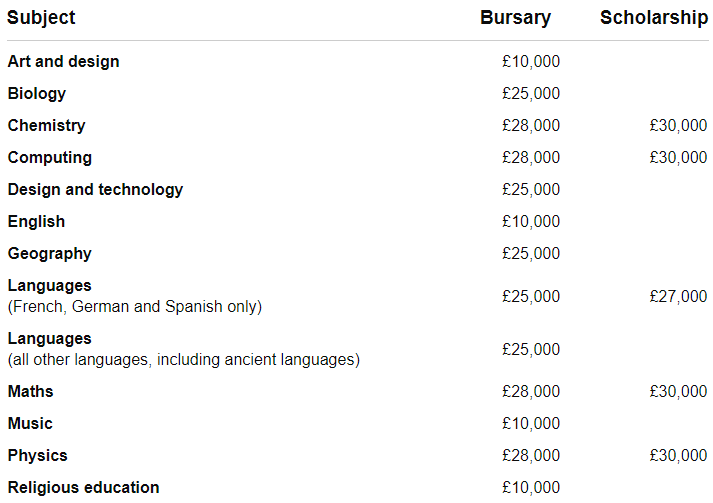Funding your teacher training
Financial support while you train
Training to teach can be a big investment and you need to consider course and living costs, which can vary between programmes and regions of the UK.
The amount of funding you receive for teacher training can vary each year and depends on:
- Your degree classification or highest relevant academic qualification
- The subject you have chosen to teach
- Where you live and plan to study
- Your personal circumstances.
- Teaching bursaries for training in England
Salaried programmes
There are some teacher training courses that come with a salary.
This means you will not have to pay tuition fees and will receive a salary while you train to get qualified teacher status (QTS). This is what you need to teach in many primary, secondary and special schools in England.
The main salaried courses include School Direct salaried, postgraduate teaching apprenticeships (PGTA) and teacher training delivered by Teach First.
All salaried courses are broadly the same, but the course length and qualifications you work towards may vary.
These courses are in high demand and very competitive, so it’s important to apply as soon as you can if you’re eligible.
Am I eligible for a salaried teacher training course?
For some salaried courses, teacher training providers may want you to have significant teaching or school experience (for example, if you’re already working as an unqualified teacher or teaching assistant).
Some also want you to have already arranged a school to work in while you train. Speak to the teacher training provider to find out what their requirements are.
You can also find out more about the qualifications you need to apply for all teacher training courses.
Or talk to a teacher training adviser who can help you understand which courses you could be eligible for.
How much will I be paid on a salaried course?
You’ll receive an unqualified teacher’s salary – the exact amount will vary depending on the school you work in.
It’s worth checking if there is a bursary or scholarship available for your subject before you apply for a salaried course.
If you do a salaried course, you will not be eligible for a bursary, scholarship or student finance. You’ll also be taxed on your income, whereas you will not be taxed on a bursary or scholarship.
If you’re eligible for a bursary or scholarship, you could receive more money on a non-salaried course than on a salaried one.
How does salaried teacher training work?
Salaried teacher training is usually similar to non-salaried teacher training – you’ll spend most of your time in school placements, with some theoretical learning.
You will not perform more than 90% of a full-time teacher’s duties (unless you’re on a postgraduate teaching apprenticeship, in which case it’s 80%).
Full-time salaried teacher training will usually last:
-
1 academic year (September to July) if you’re on a School Direct salaried course
-
2 academic years (September to July) if you’re on a course delivered by Teach First
-
at least 1 full year (September to September) if you’re on a postgraduate teaching apprenticeship – apprenticeships must last a minimum of 12 months
Some courses can begin at other points in the year and there may be part-time courses available.
Some salaried courses award QTS only. You may have the option to do a salaried course where you can work towards QTS with a postgraduate certificate in education (PGCE) but you may have to pay an extra fee.
Find out more about what to expect during your teacher training.
How do I find a salaried teacher training course?
You can find postgraduate teacher training(opens in new window) and filter by salaried courses.
It’s usually wise to apply for non-salaried courses as well to increase your chances of getting a place on a course.
You will require a supporting school who will enter into a contractual arrangement with you. The teacher training providers that you are applying to will be able to advise you on local options.
Teach First
Teach First delivers a 2-year employment-based route to teaching for high-performing graduates and career changers. You’ll earn a salary while working towards QTS with a PGCE.
To apply and find out more, you should visit the Teach First website (opens in new window).
To encourage graduates to teach certain subjects, bursaries and scholarships may be available.
You may be eligible for a bursary or scholarship if your teacher training course leads to qualified teacher status (QTS). These are tax-free amounts of money you receive to train in certain subjects. You do not need to pay them back.
Your bursary or scholarship will be paid in a minimum of 10 equal monthly instalments over the duration of your course by your teacher training provider.
Your teacher training provider will confirm the payment dates and amounts.
Postgraduate teaching bursaries and scholarships are only available for the subjects listed below if you're starting your teacher training course between September 2024 and July 2025. You cannot receive both a teaching bursary and a scholarship.

You must be eligible for student finance to receive a bursary or scholarship (unless you’re training to teach physics or languages).
You cannot receive a scholarship or bursary if you’re on a salaried teacher training course.
Click here for information on the bursaries and scholarships available.
Bursaries
You do not need to apply for a bursary. If you’re eligible, you’ll automatically receive it.
To be eligible for a bursary, you’ll need at least one of the following:
- a bachelor’s degree class 2:2 (honours) or higher
- a master’s degree
- a PhD
If your course combines 2 subjects (for example, English and history), at least 50% of your course content must be made up of the bursary subject to be eligible.
You’ll also need to meet the bursary scheme’s individual terms and conditions.
Click here to find out about your eligibility for teaching bursaries
Scholarships
An alternative to a bursary, teaching scholarships of up to £30,000 are available to fund your teacher training for some subjects only. This is set up in partnership with highly regarded professional subject associations. These competitive scholarships are aimed at those with a first or 2:1 (honours) degree.
To be eligible for a scholarship, you’ll need at least one of the following:
- a bachelor’s degree class 2:1 (honours) or higher
- a master’s degree
- a PhD
In exceptional circumstances, if you achieved a 2:2 in your degree you may still be awarded a scholarship if you have significant relevant experience.
Benefits
Scholarships are provided by charitable organisations with a passion for their subject area.
They offer more than just financial benefits, including:
- subject specialist events and webinars
- online and face-to-face workshops
- mentoring and coaching
- a community of ex-scholars, teachers and subject leaders
- access to classroom resources
- networking events during your teacher training and beyond
How to apply
Scholarships are offered by independent institutions. They set their own eligibility criteria and you’ll need to apply through the relevant scholarship body:
- the Royal Society of Chemistry(opens in new window) (chemistry)
- BCS The Chartered Institute for IT(opens in new window) (computing)
- British Council(opens in new window) (languages – French, German and Spanish only)
- the Institute of Mathematics and its Applications, and partners(opens in new window) (maths)
- the Institute of Physics(opens in new window) (physics)
Each scholarship body will have its own deadline for applications. You can find these on their individual websites.
Undergraduate bursaries
You may be eligible for a bursary of £9,000 if you do a secondary maths or physics course that leads to qualified teacher status (QTS).
You may also be eligible if you do an opt-in QTS course in secondary computing, languages, mathematics or physics. This is where you start a standard undergraduate degree but then opt-in to initial teacher training to get QTS.
The amount you receive depends on the year that you start your QTS course. You do not get a bursary in every year of an undergraduate course. Depending on the type of course you do, you may get the bursary in your final year or final two years.
Undergraduate bursary if you’re former military personnel
You may be eligible for a £40,000 tax-free undergraduate bursary for veterans if you’re:
- training to teach secondary biology, chemistry, computing, languages, maths, or physics
- doing an undergraduate degree leading to QTS in England
Find out more about how to get support training to teach if you’re a veteran.
Student loans and Tuition fees
Funding is available to help you train to teach if you choose a course that has tuition fees.
You may be eligible for a student loan to cover the cost of your tuition fees or to help with your living costs.
You can still apply for a tuition fee loan and a maintenance loan if you already have a student loan, regardless of whether you get a teaching bursary or scholarship. And you will only have to make loan repayments once you’re earning.
You do not need to wait until you have a confirmed offer for a teacher training course to apply for student funding.
If you choose a teacher training course that has a salary you’re not eligible for any student finance.
Tuition fee loan
You can apply for a tuition fee loan to cover the cost of your teacher training course. If you’re eligible for a tuition fee loan, the amount you borrow is paid directly to your course provider.
The maximum tuition fee loan for teacher training for a UK applicant is:
- £9,250 per year for a full-time course
- £6,935 per year for a part-time course
The maximum amount you can borrow depends on how much your course costs.
Tuition fees loans are not means tested. So you do not need to provide evidence of your income or anyone else’s to be eligible to receive one.
Maintenance loan
You may also be eligible for a maintenance loan to help cover your living costs.
The maximum amount you may be eligible to borrow is:
- £8,610, if you live at home with your parents
- £10,227, if you live away from your parents, out of London
- £13,348, if you live away from your parents, in London
- £4,327, if you’re 60 years or over on the first day of the academic year of your course
Use the student finance calculator on GOV.UK to get an estimate of how much funding you might get.
Click here for the Student finance calculator
If you come from outside England
You’ll need to contact your country’s student finance body to find out about your eligibility for funding if you live in Wales, Scotland, or Northern Ireland.
Find out about:
- student finance in Wales (opens in new window)
- student finance in Scotland (opens in new window)
- student finance in Northern Ireland (opens in new window)
Or, you’ll need to contact the education authority if you live in Jersey, Guernsey, or the Isle of Man.
Find out about:
- funding in Jersey (opens in new window)
- funding in Guernsey (opens in new window)
- funding in the Isle of Man (opens in new window)
Non-UK citizens
If you’re not a UK citizen, you’re unlikely to get help funding your training unless you have permission to live permanently in the UK (opens in new window), for example under the EU Settlement Scheme, or are training to teach languages or physics. You’ll also need to meet some other eligibility requirements.
Click here to find out about funding for non-UK citizens.
Maintenance loans
UK students starting a one-year postgraduate teacher training course in 2024/25 could be eligible for maintenance loan and/or tuition fee loans. Tuition fee loans are available to cover course costs, while maintenance loans are available to help with living costs. Students with children or a disability can apply for further funding from Student Finance - this could include the Childcare Grant, Parents' Learning Allowance, Adult Dependents' grants and Disabled Students' Allowance, which do not have to be paid back.
Details about these grants and the funding arrangements for trainees can be found here.
Disabled Students' Allowance (DSA)
DSA is paid in addition to other student finance to help pay the extra costs you may incur because of your disability. It does not have to be repaid, depends on your individual needs and is not assessed according to your household income. Find out more about Disabled Students' Allowances click here.
Find out what financial help is available here.
Get information about funding here

